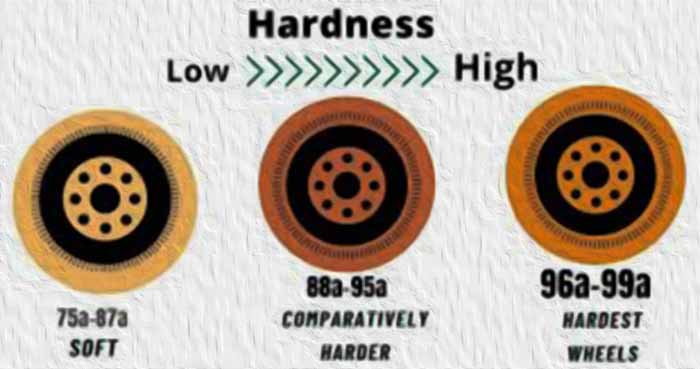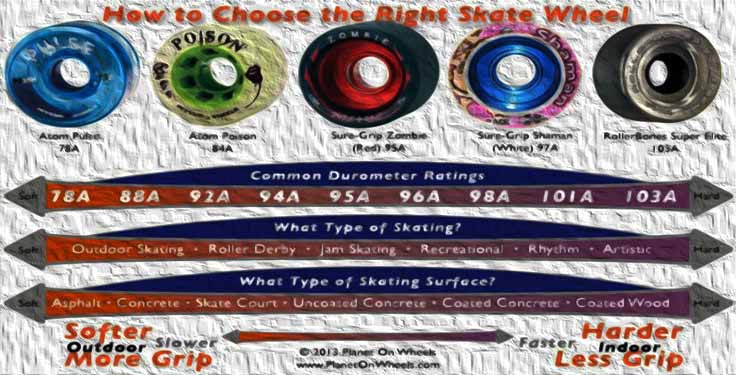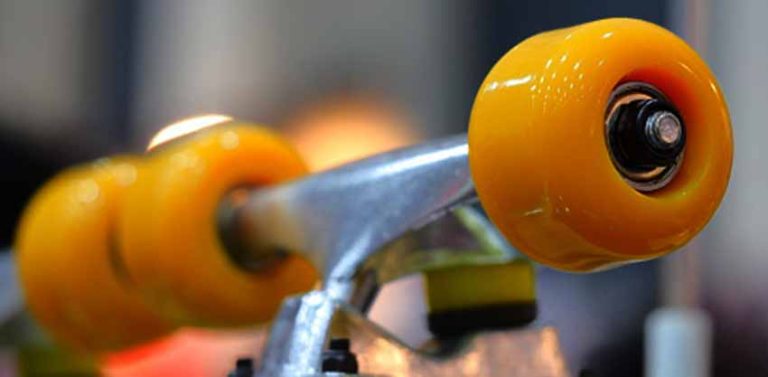Skateboard wheels are not perfect, and they do come in different sizes. The most important thing for beginners to know is how hard a wheel their skateboard needs and how to measure skateboard wheels because some brands require softer or harder materials depending on what type.
The second criterion includes understanding the various categories that fall under “softness.” These include things like urethane formulas with varying durometers. (determined by measuring tensile strength) as well as nylon vs. polyester material options.
Features to Measure Skateboard Wheels
Wheel’s Sizes
It’s essential to think about the size of your wheels before buying a skateboard. The bigger they are, the faster and easier it will be for you to transit over rough ground or even bumps in parking lots.
A good rule-of-thumb is 48 millimeters if you want something easygoing on the streets while riding around town with friends instead of 75mm+ may suit more cruiser style boards where speed isn’t that significant factor but comfortability during transport outweighs everything else by far.

A lot goes into choosing what kind of board suits one’s needs best; how much space do I have available? Do most people ride at home alone every day without supervision?
Here are the different sizes you need to learn about how To Measure Skateboard Wheels
Small sizes ranging from 48 millimeters – to 54 millimeters
Smaller boards are more agile, making them easier to control. They also allow for stunt-style moves like grinds and ollies that don’t work well with larger decks because of their weight or momentum behind them.
No matter if you’re doing street skating tricks on the pavement or fancy free-style technical stuff in pools – 51mm-52 mm skateboard sizes will suit your needs!
Large sizes ranging from 55 millimeters to 60 millimeters
A giant wheel will make your board taller and more challenging to do flip tricks. Larger wheels are better for transition skaters, as they can ride on rough surfaces without slowing down momentum or affecting their speed too much with bumps in the road.
However, this group may not work well if you plan on traveling by skateboard because it might cause an accident when riding fast through towns where traffic is sparse.
For every person who wants more stability while cruising around town at slower speeds (or even just going uphill), another individual is looking solely towards performance-oriented hobbies such as downhill mountain biking/snowboarding, etc. So one highlight point would be its ability to run smoothly over any terrain, including pavement.
Longboard Sizes ranging from 60 millimeters -75 millimeters
Many skateboarders use longboard wheels to ride through rugged surfaces. There is a variety of options for these larger, American-made longboards.
Carving or cruising; sliding on smoother surfaces like pavement with no obstacles in sight. At the same time, have fun at slower speeds than when using slides but faster ones if you want more speed (downhill racing), not to mention uphill biking.
Wheels’ Hardness
Skaters prefer softer wheels because they offer more grip. More complex surfaces like concrete and asphalt make it harder for you to control your board, but if there’s grass or dirt available in front of the house, go ahead and put some on.
Skateboard decks are usually made with plastic material. However, wood can also be used as well depending upon its durometer value.
The hardest type would typically fall under the classification “hard” at somewhere around 65-68. At the same time, ordinary old-school wooden boards that have never seen anything higher than 80+ will still work fine without cracking due to wear & tear for so long.

Durometers are a measure of the hardness or how easily one can bend an object.
They range from 78A (soft) to 101B+3(hard), with B being more difficult than A for bending objects against their natural shape without breaking them apart first.
Sizing is based on this scale where higher numbers signify harder surfaces, so wheels at number 84 will be equal compared to 104a sized ones.
Different levels of hardness are due to various skating styles also.
Range of 75A to 80A
The 75A to 80A range of speed is perfect for navigating through town or cruising around. You can test how soft your wheels are by touching them with a finger, but be careful not to scratch the paint job.
Range of 80A-90A
When you are at an 80-90A level, the material gets harder and quieter. This means that it’s not the best for landing since there isn’t much bounce compared to other snowboarding groups or any competition where judges look at technicality in tricks done on flat ground and during riding downhill, which I did most back then.
Range Up from 90A
Street skaters need wheels that can withstand high speeds and even slippery ground. The durometer range of 90A to 150B is perfect for these types of skateboarding environments because they enable better tricks, providing professional techniques with ease while staying in control of your board at all times.
Recommended Wheel Size for Variety of Terrain
In the case of a hard wheel, 54mm is probably best for street riding. This size provides riders with enough speed and acceleration to do basic tricks. But not much else due to its limited range in other terrains such as ramps or sloped surfaces which might be more appropriate.

Suppose you’re looking at skateboarding overall, then just mapping specific challenges like a backflip from one rail onto another.
Final Verdict
The article will teach you how to measure skateboard wheels, which is essential for amateurs or pros. There are many sizes and styles available so it’s up to the preference of what type suits one’s needs best.
Thanks for reading. If you have any questions you can ask them in the below comment box.
- See Also: How To Change Skateboard Wheels – Practical Guide
